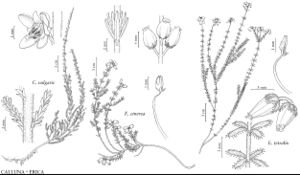Difference between revisions of "Erica tetralix"
Sp. Pl. 1: 353. 1753 ,.
FNA>Volume Importer |
FNA>Volume Importer |
||
| Line 47: | Line 47: | ||
|publication year= | |publication year= | ||
|special status= | |special status= | ||
| − | |source xml=https://jpend@bitbucket.org/aafc-mbb/fna-data-curation.git/src/ | + | |source xml=https://jpend@bitbucket.org/aafc-mbb/fna-data-curation.git/src/8f726806613d60c220dc4493de13607dd3150896/coarse_grained_fna_xml/V8/V8_965.xml |
|subfamily=Ericaceae subfam. Ericoideae | |subfamily=Ericaceae subfam. Ericoideae | ||
|genus=Erica | |genus=Erica | ||
Revision as of 19:10, 18 September 2019
Plants erect or ascending, 10–25 cm; twigs of current season green, with both appressed and spreading, stiff hairs, older twigs brown, glabrescent. Leaves in whorls of 4; petiole 0.1–0.3 mm; blade linear-lanceolate, flat, 3–5.5 × 0.5–0.7 mm, margins revolute, not prickled, abaxial surface stiffly short-hairy, adaxial sparsely, stiffly short-hairy (hairs ca. 0.1–0.2 mm), mixed with longer, glandular hairs (hairs 0.5–0.6 mm). Inflorescences terminal umbels, capitate, 0.8–1.6 cm. Pedicels 2–3 mm, glabrous. Flowers: calyx lobes narrowly deltate, 2.5 × 0.6–0.8 mm, margins entire, with short, stiff hairs, apex obtuse, with short, stiff hairs; corolla light pink, campanulate, 4–5 mm, lobes deltate, 0.5 mm, apex acute; stamens 10; filaments ca. 3 mm; anthers awned, ca. 0.7 mm, awns 2, basal, subulate, ca. 0.7 mm; ovary hairy; style 3–4 mm; stigma included, not slender, capitate. Capsules 1.5–2 mm. Seeds ellipsoid-ovoid, 0.3 × 0.3 mm, reticulate. 2n = 24.
Phenology: Flowering late spring–summer.
Habitat: Sandy, acidic, upland sites in old pastures and roadsides
Elevation: 0-1100 m
Distribution

N.S., Conn., Maine, Mass., N.H., N.J., N.C., Ohio, W.Va., n, w Europe.
Discussion
Selected References
None.
